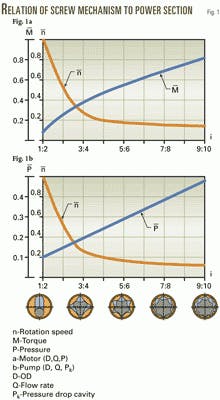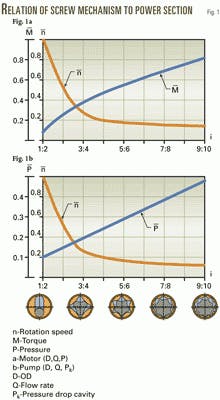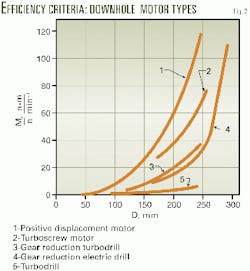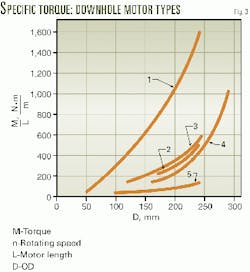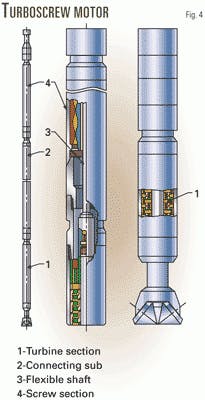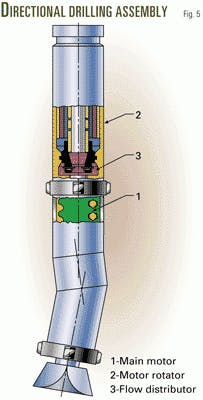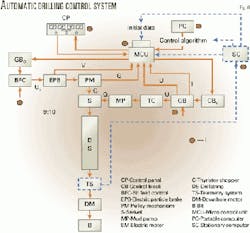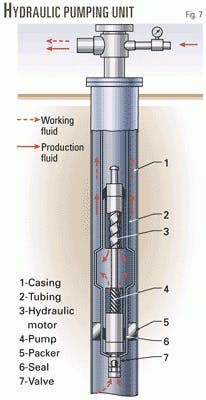Multilobe positive displacement motors (PDM) now compete against rotary and turbodrills in Russia's drilling sector, with promising prospects for worldwide applications.
This technology, first developed by the Scientific Production Association of Drilling Techniques (VNIIBT, Moscow) in the 1960s and 1970s, incorporates two or more helical bends along the rotor and stator where the transverse cross sections are defined by cycloidal curves.
In contrast, the more traditional Moineau design employs a single helical bend, geometrically portrayed by a circular rotor cross-section, along the power section.
In the 1980s and 1990s, VNIIBT advanced the multilobe design with substantial improvements in torque efficiencies that now allows these tools to compete with rotary and turbodrills in vertical, directional, and horizontal drilling operations (Figs. 1-3).
By early 1999, Russian multilobe PDMs drilled 27 million m of hole at depths up to 5,560 m. Currently, there are about 50 Russian and international patents in place.1
Russian experience
Russian manufacturers produce 50 standard PDM motor sizes ranging from 48 to 240 mm OD. These units utilize a kinematic power section with ratios ranging from 4:5 to 14:15.3 Depending on the application, each multilobe PDM differs in relation to the bearing assembly, rotor connection, and engineering accessories (housing bending mechanism, centralizers, joints, etc.).
When drilling with modern journal-bearing rock bits, footage has been shown to increase 1.5-4 fold over the turbine method of drilling. Clear examples of such improvements are recorded in the Ural-Volga region (hard rocks) at depths to 1,000 m and in Siberia (soft rocks) at depths to 2,500 m.
Prospects of MSM
Engineers have identified seven applications for multilobe PDMs. First, as early as 1970, drillers proposed using multilobe PDMs as an adjusting section to the turbodrill (Fig. 4).4
The successive passage of mud flow through the turbine and screw sections along the mechanical connection of these shafts have been shown to radically change the outlet characteristics of the downhole tool and expand its operational range with a considerable increase in torque.
This invention made way for many designs of next-generation turbodrills known as turboscrew motors or compound motors.
Second, by placing a multilobe PDM above the main motor, engineers found they could improve stabilization and build rate for directional and horizontal applications (Fig. 5).5
Third, drillers can control drilling efficiencies by measuring the pressure drop as a function of torque. This becomes especially important as information recorded at the surface does not indicate true drillstring weight or bit loading while drilling deviated and horizontal wells.
Currently, the monitoring of the drilling process focuses on the response of the mud pump drive motor in relation to the change of injection pressure as bit weight varies from predetermined factors.6 Instead, an automatic control system, which combines the control systems of the mud pump and autodriller, uses computerized algorithms to improve the drilling process (Fig. 6). The above system can function as a self-contained unit or in conjunction with a measurement-while-drilling system.
Fourth, the system can utilize a downhole feed mechanism through modifications of a conventional motor that includes a portable rotor or telescoping section that is connected to the motor housing in the drill string.7 Applications for this contiguous metal string mechanism includes the maintenance of constant axial bit weight while drilling horizontal wells.
Fifth, for progressing cavity pumps, a multilobe power section can increase pumping efficiencies.8 During production, multilobe screw pairs can be applied to sucker rod pumps, well pumps with adjustable submersible electric motors, and injection units involved with high-viscosity liquids and gas-fluid mixtures.9
Sixth, multilobe PDMs can be used in the step-up section positioned between the submersible electric motor and centrifugal pump.10 The electric motor shaft is connected through a flexible joint to the multilobe rotor (preferably a two or three-lobe configuration) fitted with a bore in the upper section and a crank joint mounted to the pump shaft.
If the mechanism length is no less than the pitch of the screw stator surface, the multilobe PDM will combine the functions of the step-up gear and booster pump.
The upper section can increase pumping efficiencies 2-3 fold.
Finally, multilobe PDMs can be used for hydraulic drive pumping unit applications (Fig. 7). As early as the 1970s, Russian engineers suggested a hydraulic drive unit design based on a multilobe PDM.
As compared to hydraulic drive piston pumping units, there are no valves or control valves to process water as a working fluid for the hydraulic motor. Thus, the simple design improves its reliability. Additionally, a multilobe PDM can pump high gas content liquids at the inlet.
As opposed to sucker rod pumps, a multilobe PDM can operate in complicated profile wells including directional wells with high build rates. Smooth adjustment of the pump's rotating speed is provided by simple adjustments to the flow rate.
References
- Hydraulic Downhole Positive Displacement Motors, USSR Patent No. 237596, 07.06.1966.
- Gusman, M., and Baldenko, D., "Downhole Positive Displacement Motors," VNIIOENG, Moscow, 1972, p. 84.
- Baldenko, D., Baldenko, F., and Gnoyevyikh, A., "Positive Displacement Downhole Motors," Nedra, Moscow, 1999, p. 375.
- Downhole Motor, USSR Patent No. 346967, 27.05.1970.
- Steerable Downhole Motor for Directional and Horizontal Well Drilling, Russian Federation Patent No. 2131967.
- Control Method While Drilling with Hydraulic Downhole Motor, USSR Prior Patent No. 2065956, 15.04.1994.
- Downhole motor, USSR Patent No. 443156, 10.05.1973.
- Multilobe Progressing Cavity Pump, USSR Patent No. 1286814, 15.05.1984.
- Baldenko, D., and Baldenko, F., "Multilobe Progressing Cavity Pump: Operating Process Peculiarities, Geometrical Parameters Optimization and Fields of Application," Progressing Cavity Pump Workshop, Tulsa, 1996.
- Submersible Electric Pumping Unit, USSR Patent No. 363814, 19.10.1970.
- Submersible Hydraulic Drive Pumping Unit, USSR Patent No. 521399, 06.07.1973.
The authors
Dmitry F. Baldenko is a chief designer of screw hydraulic machines at the Scientific Research Institute of Drilling Techniques (VNIIBT) in Moscow. He graduated from the Moscow Oil Institute I. Gubkin and holds a PhD in mechanical engineering. Baldenko has more than 40 years of experience in design, research, and testing of downhole progressing cavity pumps and PDMs. He is the author of 280 publications and patents.
Yuri A. Korotaev is a director of VNIIBT's Perm Division and is the chief specialist in the area of screw hydraulic machine manufacturing. He has more than 25 years' experience in design, research, and manufacturing of this equipment. Korotaev graduated from Perm Polytechnic Institute and holds a candidate degree in technical science from Tulsk Polytechnic Institute. He is the author of 80 publications and patents.
Feodor D. Baldenko graduated from Russian State Oil & Gas University I. Gubkin. He is senior lecturer at this University. Baldenko also holds a candidate degree in technical science from Russian State Oil & Gas University in Moscow. His research interests include screw hydraulic machines and he has 20 years of experience in drilling equipment. He is the author of 50 publications and patents.
